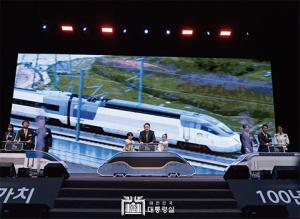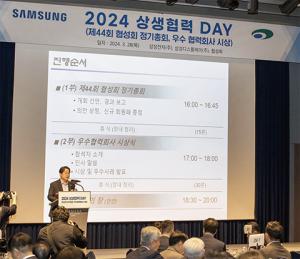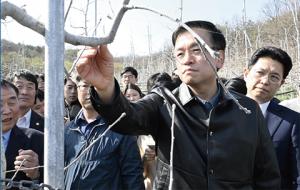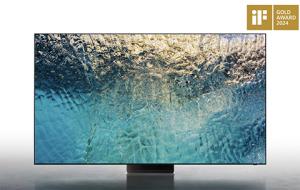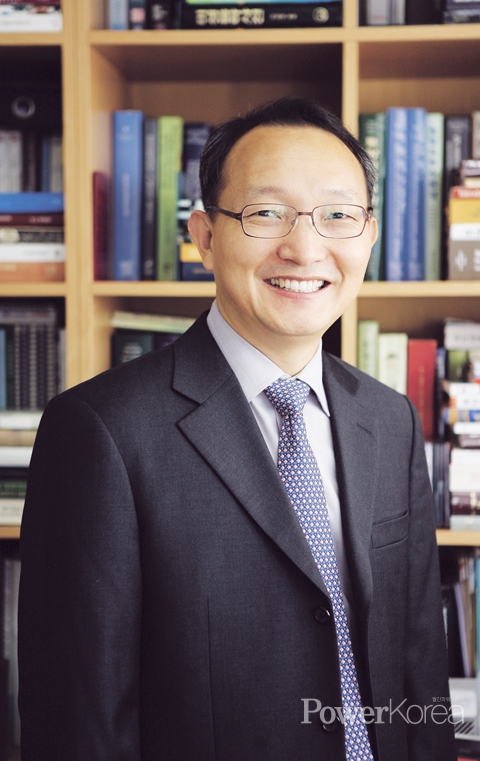 |
||
| ▲ 전남대학교 토양·지구미생물연구실 노열 교수 | ||
우리들은 지구를 일컬어 ‘생명의 보고(寶庫)’라고 부른다. 지구상에는 수백만 종의 생물이 살고 있으며, 현미경을 통해서만 관찰할 수 있는 미생물의 경우 지금까지 발견된 것만 1000만 종에 달하는 것으로 보고되고 있다. 그리고 이러한 미생물들은 생명이 살 수 없을 것이라 여기기 쉬운 극한 환경에서도 살아남으며 저마다의 독특한 생화학적 작용을 일으키고 있다.
지구미생물을 발굴하여 이산화탄소를 광물 포획하는 기술 개발에 매진
전남대학교 지구환경과학부의 노열 교수는 지질학과 미생물학의 융합학문인 ‘지구미생물학(Geomicrobiology)’ 분야에 대한 연구에 매진해 온 인물로, 지난 2008년 한국광물학회 젊은 과학자상, 2009년 한국연구재단 기초연구사업 우수 평가자 선정, 2014년 대한지질학회 학술상, 2017년 춘계 지질과학기술 공동학술대회 학술 논문상을 수상하는 등 관련 분야 연구의 권위자로 인정받고 있다. 그는 “지구미생물은 다양한 환경에 생존하면서 광물의 풍화, 변형, 합성 등의 지화학적 작용으로 전지구적 원소순환에 매우 중요한 역할을 담당하고 있습니다. 뿐만 아니라 최근에는 의료, 제약, 첨단소재, 자원, 에너지, 환경, 식품 등 거의 모든 산업에 영향을 미치는 중요한 자원으로 각광받고 있습니다”라고 설명했다. 이에 노열 교수는 「토양·지구미생물연구실」을 개설하고, 갯벌이나 해양, 지하 심부, 극지 등 지구의 다양한 환경에 서식하는 미생물의 발굴과 이들의 대사 작용을 이용한 지구환경보존 및 산업적 응용 연구에 주력하고 있다. 최근 토양·지구미생물 연구팀은 광물탄산화를 촉진하는 지구미생물을 발굴하여 이산화탄소를 광물 포획하는 기술 개발에 매진한 가운데, 홍조단괴에서 서식하는 탄산염광물 형성 미생물인 ‘프로테우스 미라빌리스(Proteus mirabilis)’가 칼슘과 마그네슘이 풍부한 해양환경에서 다양한 방해석 형성에 중요한 역할을 담당하고 있음을 국내 최초로 규명했다. 현재는 이러한 기술을 바탕으로 미래창조과학부의 ‘CCS 2020’ 사업 중 이산화탄소 지중저장 혁신과제에 참여하고 있다. 연구팀은 이산화탄소 지중지장 후보지인 포항 장기분지 지하 1,000 m 부근 암석과 지하수에서 토착미생물인 ‘클로스트리디움(Clostridium sp.)과 슈와넬라(Shewanella sp.)’를 농화배양하고, 이들 미생물로 다양한 탄산염광물(예: CaCO3, MgxCa1-xCO3, SrCO3, CdCO3, FeCO3, MnCO3 등)을 합성하는 기술을 획득하였다. 이를 통해 지하심부 토착 미생물에 의한 CO2 저장 덮개암의 밀봉능력 향상 기술을 개발하고, 스트론튬이나 카드뮴 같은 방사성핵종원소 또는 중금속 오염 물질 고정 기술개발[스트론튬 고정 방법 및 이를 위한 조성물(특허등록 번호: 10-1384454), 이산화탄소 고정 방법 및 이를 위한 조성물(특허등록 번호: 10-1384465) 하였다. 지구미생물의 광물탄산화 응용으로, 방해석 형성 시 세륨(Cerium, Ce), 유로피움(Europium, Eu), 테비륨(Terbium, Tb) 같은 형광물질을 도핑 함으로써 산업적으로 다양하게 이용 가능한 신소재물질(형광체, Phosphors)도 합성[홍조단괴 유래 미생물을 이용한 형광 탄산염광물 합성방법 및 이를 위한 조성물(특허 출원번호: 10-2016-00300233)]과 방해석 침전을 이용한 암석의 균열충진과 이산화탄소의 지중저장 시 덮개암의 균열과 틈을 충진하여 저장능력 향상[홍조단괴 유래 미생물을 이용한 방해석 침전방법 및 이를 위한 조성물(특허 출원번호: 10-2017-0001437)]에 적용할 수 있을 것으로 기대된다.
지구환경보존을 위한 금속 원소의 순환, 회수 및 활용에 주목
연구팀에서는 지구미생물에 의한 금속 원소의 순환에 주목하여, 금속 침전과 금속 용출 연구에 주력하고 있다. 노열 교수와 연구팀은 “금속환원미생물은 혐기환경에서 철을 포함한 다양한 중금속을 호흡과 대사활동에 활용합니다. 이를 통해 합성한 자철석은 입자의 크기와 모양이 균일할 뿐만 아니라, 친환경적이고 저독성인 안전한 나노 광물로서 약물전달체나 토양·지하수 오염정화 촉매제 등 산업적 이용이 가능할 것으로 전망하고 있습니다”라고 밝혔다. 연구팀은 이러한 미생물 생성 나노물질을 이용해 ‘오·폐수 및 지하수 정화기술’을 개발[하여 환경부 GAIA 사업에 참여하고 있다(중금속 제거용 나노 황화철화합물 제조방법 및 중금속 오염수 정화방법(특허 출원번호: 10-2016-0001742), 나노크기의 미생물 생성 자철석을 이용한 중금속 오염수 정화 방법(특허 출원번호: 10-2016-0013598). 지구미생물의 산화-환원 반응과 생광물화작용은 금과 은 같은 귀금속의 침전과 회수에도 적용이 가능하다. 반면, 미생물을 이용하여 고체 상태의 금속을 이온 형태로 용출(Bioleaching) 할 수도 있는데, 연구팀에서는 최근 홍조단괴에서 구리 용출능이 뛰어난 미생물을 확보하고 폐휴대폰의 PCB로부터 고순도의 구리를 용출하는데 성공하였다. 현재는 습식제련법과 미생물용출법을 적용하여 간단한 방법으로 폐자원(폐전자제품 및 저품위광석)의 금속을 분리·회수하는 친환경적 금속 재활용 기술 개발에 매진하고 있다. 이와 같은 미생물학적 금속 침전 또는 용출 기술은 산업폐수나 폐자원의 금속 재활용, 더 나아가 해양과 갯벌 등에서의 금속 회수에 응용될 수 있을 것으로 연구팀은 내다보고 있다. 노열 교수는 “저희 연구팀은 토착 지구미생물의 발굴 및 연구를 기반으로 유용 나노광물의 합성과 나노 소재 개발, 폐자원으로부터의 금속 회수, 그리고 이산화탄소 고정, 토양·지하수 정화와 같은 다양하고 독창적인 응용 분야로 연구를 확대하고 있습니다. 지구미생물 연구를 통해 보다 경제적이고 친환경적인 기술 개발을 선도하고 있는 「토양·지구미생물연구실」과 노열 교수의 행보에 귀추가 주목되고 있다.
Development of innovative NT-BT technology with geomicrobiology
Prof. Yul Roh of Chonnam National University Soil & Geomicrobiology Laboratory
Development of technology for mineral capture of carbon dioxide (CO2)
Prof. Yul Roh has devoted his life to research on geomicrobiology, an integrated study of geology and microbiology. He got the young scientist prize from the Mineralogical Society of Korea (2008), chosen for the excellent evaluator of the research projects by the National Research Foundation (2009), won the scholarly prize from the Geological Society of Korea ( 2014) and the academic research paper prize from the Korean Society of Economic and Environmental Geology (2017) "Geomicrobes plays very important roles in the cycle of the elements with its geochemical reactions such as weathering, transformation and synthesis of the minerals in the subsurface environments. Prof. Yul Roh said as follows: Microbes live in diverse in (sub)surface environments of Earth and play important roles for weathering, alternation, and syntheses of minerals and element cycles via biogeochemical processes. They also play key roles for medicine, advanced materials, energy, resources, environment and food. He opened 'Soil & Geomicrobiology Laboratory' in order to search microorganisms that live in the inter-tidal flat sediments, ocean sediments, deep underground rocks and the polar region. The laboratory uses the metabolism of the microorganisms for conservation of our Earth and industrial application. Prof. Roh’s research team has currently interested in development of technologies for mineral capture of carbon dioxide (CO2) via biomineralization. The team established for the first time in Korea that 'Proteus mirabilis', the carbonate mineral forming microorganism enriched from rhodolith, plays an important role in forming various carbonate minerals such as calcite, Mg-rich calcite, strontianite, siderite, rhodochrosite. In recognition of this achievement, the Ministry of Science, ICT and Future Planning invited the team to the carbon dioxide underground storage innovation task of the 'CCS 2020' project. The team enriched the indigenous microbes such as Clostridium sp. and Shewanella sp. that live in the 1,000 meter underground rocks and water at the Janggi Basin in Pohang City (the proposed site of the carbon dioxide underground storage). Those microbes synthesize carbonate minerals such as CaCO3, MgxCa1-xCO3, SrCO3, CdCO3, FeCO3, MnCO3, etc. As a result, the team developed the sealing improvement technology of cap rock for the geologic sequestration of carbon dioxide. The team also registered patents including immobilization of radionuclides and heavy metals and its composite (patent No.10-1384454) and the carbon dioxide fixing method and its composite (patent No.10-1384465). The team developed the biomineralization of fluorescent materials (i.e., phosphors) such as cerium-, europium- and terbium-doped carbonate minerals (No.10-2016-00300233, Fluorescent Carbonate Mineral Synthesis Method & Composite) that can used for the industries. The teams also used the calcite precipitation to fill the cracks of the rocks and the cracks that improves the storage performance by sealing of the cap rocks (No.10-2-17-0001437, Microorganism-based Calcite Precipitation Method & Composite).
Focusing on cycling, recovery, and uses of metals for the Earth conservation
The team paid attention to the microbial cycles of elements mainly focused on metal precipitation and metal bioleaching. "Metal reducing microorganism uses a variety of heavy metals including iron and manganese in the anaerobic environment for respiration and metabolism. The magnetite synthesized by this process has the particles that have homogeneous size and shape and it is an eco-friendly and non-toxic nano-material. For this reason, the bio-magnetite can be used as drug transporter or catalysts for remediation of water" explains Prof. Yul Roh. By using microbial syntheses of nano-materials, the team developed 'Wastewater and Groundwater Purification Technology' and registered a patent (No.10-2016-0001742) entitled nano iron sulfide compound production method for removing heavy metals and heavy metal pollutant purification method and another patent (No.10-2016-0013598) entitled method for simultaneous removal of nitrate and chromate in contaminated water using metal-reducing bacteria and biogenic magnetite nano-sized particles. As a result, the team currently is participating in the GAIA Project of the Ministry of Environment. It is also possible to do bioleaching the precious metals from used electronics by using microorganism and the team obtained the microorganisms from rhodolith that have excellent copper bioleaching ability and succeeded bioleaching and recovery of the high purity copper from PCB of the used mobile phones. Currently, the team is working on development of eco-friendly metal recycling technology by using hydrometallurgy and bioleaching and it is expected to be used for recycling industrial wastewater, waste resources and collecting metals from ocean or the mud. "We are expanding our research scope to recycling, collecting and application of metallic elements, development of nano-materials, wastewater purification and to more unique and innovative application areas with which we will take the initiative in leading the eco-friendly geomicrobiol technologies.' <Power Korea> sends a message of support.
임승민 기자 press0105@naver.com

